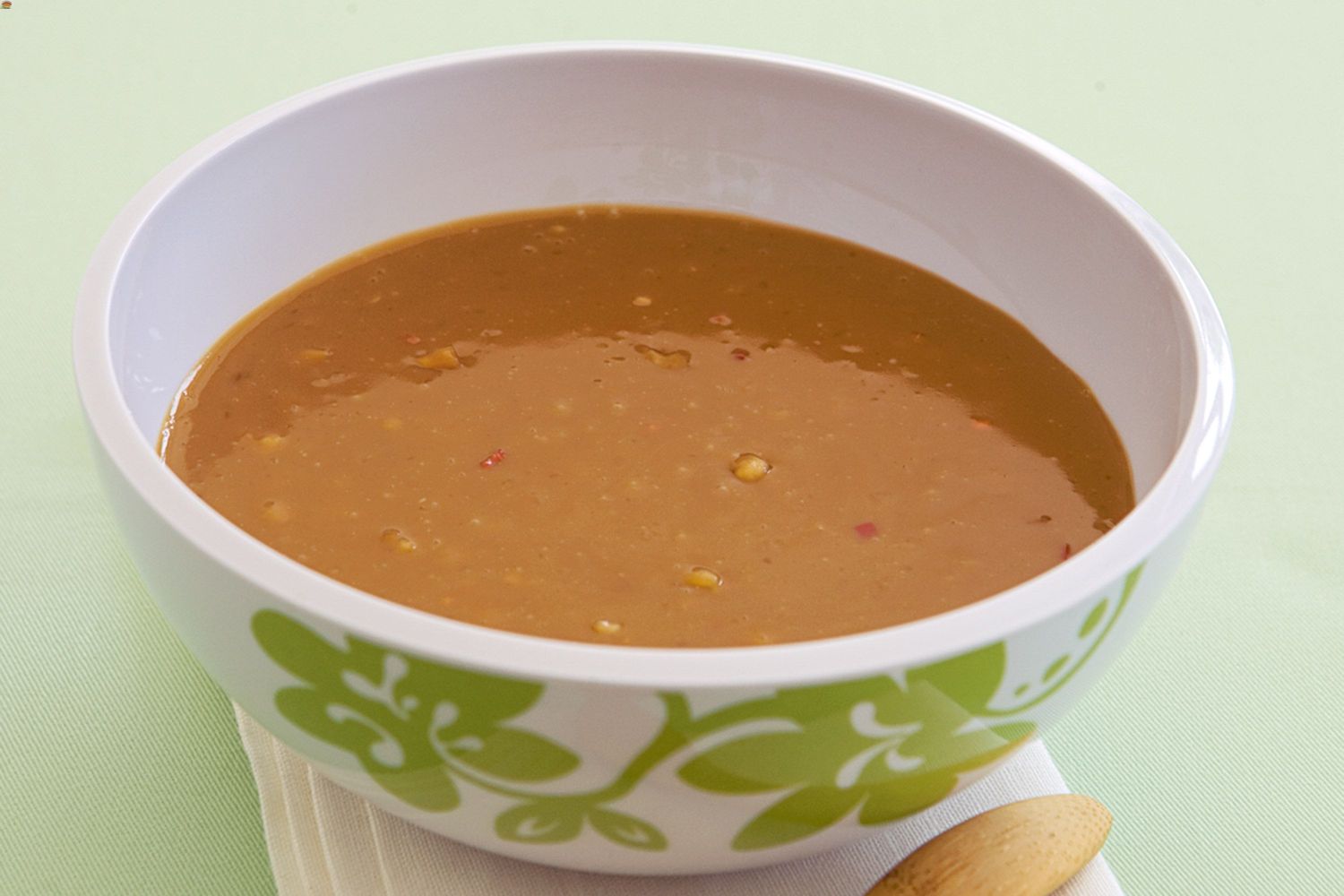Satay sauce is a delicious and versatile condiment that can elevate a variety of dishes. This rich and creamy sauce, with its perfect balance of sweet, salty, and spicy flavors, is a staple in Southeast Asian cuisine. Whether you're using it as a dip for skewered meats or as a dressing for salads, this homemade satay sauce will add an exotic touch to your meals.
Some of the ingredients in this recipe may not be commonly found in every household. For instance, coconut milk is a key component that adds a creamy texture and subtle sweetness to the sauce. You might also need to pick up lime juice for its tangy flavor, and chili flakes to give the sauce a bit of heat. These items are usually available in the international or Asian food section of most supermarkets.

Ingredients For Satay Sauce Recipe
Peanut butter: Provides the rich, nutty base for the sauce.
Coconut milk: Adds creaminess and a subtle sweetness.
Soy sauce: Contributes a salty, umami flavor.
Brown sugar: Balances the flavors with its sweetness.
Lime juice: Adds a tangy, citrusy note.
Garlic: Offers a pungent, aromatic flavor.
Ginger: Provides a warm, spicy undertone.
Chili flakes: Adds a touch of heat to the sauce.
Technique Tip for Making Satay Sauce
When preparing this satay sauce, ensure that the peanut butter you use is smooth and not chunky, as this will help achieve a more consistent texture. Additionally, finely mince the garlic and grate the ginger as finely as possible to ensure they blend seamlessly into the sauce. For a more intense flavor, consider toasting the chili flakes briefly in the saucepan before adding the other ingredients. This will release their oils and enhance the overall spiciness of the sauce.
Suggested Side Dishes
Alternative Ingredients
peanut butter - Substitute with almond butter: Almond butter provides a similar creamy texture and nutty flavor, making it a good alternative for those with peanut allergies.
coconut milk - Substitute with almond milk: Almond milk can be used as a lighter alternative, though it may not be as rich and creamy as coconut milk.
soy sauce - Substitute with tamari: Tamari is a gluten-free alternative to soy sauce and has a similar salty and umami flavor.
brown sugar - Substitute with honey: Honey adds sweetness and a slightly different flavor profile, but it works well in balancing the savory elements of the sauce.
lime juice - Substitute with lemon juice: Lemon juice provides a similar acidity and citrus flavor, making it a suitable replacement for lime juice.
garlic - Substitute with garlic powder: Garlic powder can be used in place of fresh garlic, though it may lack the same depth of flavor.
ginger - Substitute with ground ginger: Ground ginger can be used as a substitute for fresh ginger, though it may be slightly less pungent.
chili flakes - Substitute with cayenne pepper: Cayenne pepper can provide a similar level of heat and spice, though it may be more intense, so use sparingly.
Other Alternative Recipes Similar to This
How to Store or Freeze This Sauce
Allow the satay sauce to cool completely at room temperature before storing. This helps prevent condensation, which can affect the texture and flavor.
Transfer the cooled sauce into an airtight container. Glass jars with tight-fitting lids or BPA-free plastic containers work best to maintain freshness.
Label the container with the date of preparation. This ensures you keep track of its shelf life and use it within a safe period.
Store the satay sauce in the refrigerator. It will keep well for up to one week. The cold temperature helps preserve the flavors and prevents spoilage.
For longer storage, consider freezing the sauce. Pour the satay sauce into freezer-safe containers or heavy-duty freezer bags. Leave some space at the top to allow for expansion as the sauce freezes.
If using freezer bags, lay them flat in the freezer. This not only saves space but also allows the sauce to freeze and thaw more evenly.
To thaw frozen satay sauce, transfer it to the refrigerator and let it defrost overnight. For a quicker method, place the sealed container or bag in a bowl of cold water.
Once thawed, give the sauce a good stir to recombine any separated ingredients. Reheat gently on the stovetop over low heat, stirring occasionally, until warmed through.
Avoid refreezing the satay sauce once it has been thawed. This can affect the texture and flavor, and may also pose a food safety risk.
If you notice any off smells, discoloration, or mold, discard the sauce immediately. Always prioritize food safety to ensure the best culinary experience.
How to Reheat Leftovers
For a quick and easy method, use the microwave. Place the satay sauce in a microwave-safe bowl. Heat on medium power in 30-second intervals, stirring in between, until the sauce is warmed through and smooth.
If you prefer a more controlled reheating process, use the stovetop. Pour the satay sauce into a small saucepan. Heat over low to medium heat, stirring frequently to prevent sticking and ensure even heating. Add a splash of coconut milk or water if the sauce becomes too thick.
For those who enjoy a bit of a smoky flavor, try reheating on a grill. Place the satay sauce in a heatproof dish and set it on the grill over indirect heat. Stir occasionally until the sauce is warmed through.
If you have a double boiler, this method is excellent for gentle reheating. Place the satay sauce in the top part of the double boiler and heat over simmering water, stirring occasionally until the sauce is smooth and warm.
For a creamy consistency, consider using a slow cooker. Set the slow cooker to the warm setting and place the satay sauce inside. Stir occasionally until the sauce reaches the desired temperature.
Best Tools for Making Satay Sauce
Saucepan: A medium-sized pan used for combining and heating the ingredients.
Whisk: Essential for mixing the ingredients together until smooth and well combined.
Measuring cups: Used to measure the peanut butter and coconut milk accurately.
Measuring spoons: Necessary for measuring the soy sauce, brown sugar, lime juice, and other small quantity ingredients.
Garlic press: Handy for mincing the garlic clove efficiently.
Grater: Used to grate the ginger finely.
Spatula: Useful for scraping down the sides of the saucepan to ensure all ingredients are well mixed.
Cutting board: Provides a surface for mincing the garlic and grating the ginger.
Knife: Used for cutting and preparing the garlic clove before mincing.
How to Save Time on This Recipe
Use pre-minced garlic and ginger: Save time by using store-bought minced garlic and grated ginger instead of preparing them from scratch.
Measure ingredients in advance: Measure out all your ingredients before you start cooking to streamline the process.
Microwave peanut butter: Slightly warm the peanut butter in the microwave for easier mixing.
Use a whisk: A whisk can help you combine the sauce ingredients more quickly and smoothly.
Double the batch: Make a larger batch of satay sauce and store the extra in the fridge for future use.

Satay Sauce Recipe
Ingredients
Main Ingredients
- 1 cup Peanut Butter
- 1 cup Coconut Milk
- 2 tablespoon Soy Sauce
- 2 tablespoon Brown Sugar
- 1 tablespoon Lime Juice
- 1 clove Garlic, minced
- 1 teaspoon Ginger, grated
- 1 teaspoon Chili Flakes
Instructions
- 1. In a saucepan, combine all ingredients.
- 2. Cook over medium heat, whisking constantly until smooth and slightly thickened, about 5-7 minutes.
- 3. Remove from heat and let cool slightly before serving.
Nutritional Value
Keywords
More Amazing Recipes to Try 🙂
- Aperol Spritz Recipe5 Minutes
- Vegan Cilantro Lime Sweet Potato Black Bean Tacos Recipe40 Minutes
- Vegan Lentil Salad with Apples and Carrot Recipe40 Minutes
- Air Fryer Vegan Burger Recipe35 Minutes
- Vegan Coconut Curry with Tofu Recipe45 Minutes
- Vegan Black Bean Burgers Recipe25 Minutes
- Vietnamese Fresh Spring Rolls Recipe20 Minutes
- Vegan Spaghetti Squash Recipe1 Hours

Leave a Reply